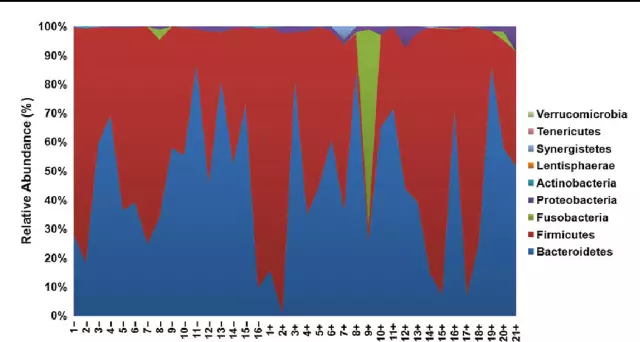- Author Rachel Wainwright [email protected].
- Public 2023-12-15 07:39.
- Last modified 2025-11-02 20:14.
Intestinal dysbiosis
The content of the article:
- Causes and risk factors
- Forms of the disease
- Intestinal dysbiosis symptoms
- Diagnostics
- Treatment of intestinal dysbiosis
- Potential consequences and complications
- Forecast
- Prevention

Intestinal dysbiosis (dysbiosis) is a pathological condition that is caused by a change in the normal species composition of bacteria in the large intestine, namely, an increase in the number of pathogenic microorganisms and a decrease in the content of lacto- and bifidobacteria.
In an adult, over 500 species of microorganisms with a total weight of about 2 kg live in the intestines. They are directly involved in the process of digesting food and are necessary for the body, therefore they are called symbiotic bacteria. Normally, the species and quantitative composition of the intestinal microflora is in a state of equilibrium, which is called eubiosis (normobiocenosis). This balance can be disturbed under the influence of provoking factors (intestinal infections, food intoxication, antibiotic therapy, treatment with immunosuppressants, gross errors in nutrition), which leads to the development of intestinal dysbiosis and associated digestive disorders.
Intestinal dysbiosis is not an independent disease. A change in the composition of the intestinal microflora always occurs under the influence of certain negative factors, after the elimination of which, in most cases, intestinal dysbiosis passes on its own.
In Western Europe and North America, the diagnosis of intestinal dysbiosis is never made. In Russia, this pathology is mentioned in the Protocols (Standards) for the Diagnosis and Treatment of Diseases of the Digestive System, approved by order of the Ministry of Health of the Russian Federation No. 125 dated 04.17.98. However, even here intestinal dysbiosis is indicated only in connection with any other intestinal pathologies. In fact, intestinal dysbiosis is one of the signs of the disease, a microbiological concept, and not an independent nosological unit.
Causes and risk factors
The entire human intestinal microflora is divided into several groups:
- obligate (obligatory) - represented by Escherichia coli, lactobacilli and bifidobacteria; plays an important role in the process of digestion, synthesis of a number of vitamins, metabolism, regulation of immunity;
- opportunistic (optional) - it includes yeast fungi of the genus Candida, Clostridia, Klebsiela, Proteus, Enterobacter, epidermal and Staphylococcus aureus; normally should not exceed 0.6% of all intestinal microflora and cause the development of diseases;
- transient - its representatives are not characteristic of the human body, their appearance in the intestine is transient, that is, temporary (flavobacteria, acinetobacteria, etc.);
- pathogenic - microorganisms belonging to this group cause infectious diseases (salmonellosis, dysentery, escherichiasis); normally, this microflora should not be present in the intestine.
The normal intestinal microflora has many functions:
- energetic - supplies the epithelial cells of the intestine with molecules of adenosine triphosphoric acid (ATP), i.e., provides them with an energetic substrate;
- trophic - promotes the breakdown and assimilation of products entering the body, thereby providing the human body with nutrients;
- peristaltic - bacteria in the process of their vital activity release chemicals that irritate the intestinal wall and thereby stimulate its peristalsis;
- regenerative - takes part in the differentiation of intestinal epithelial cells during their renewal;
- protective - participates in the regulation of local immunity, the synthesis of immunoglobulins, reads the genomes of pathological microorganisms, captures viruses, increases the resistance of intestinal mucosa cells to the effects of carcinogenic and other pathogenic factors.
In addition to all of the above, the normal intestinal microflora is directly involved in the regulation of the gas composition of the intestine, electrolyte balance, the activation of certain drugs, the deactivation of poisons, the formation of signal markers, neurotransmitters, biologically active substances, the synthesis of pantothenic acid and B vitamins.

Source: online.org
A change in the ratio of obligate and conditionally pathogenic flora, which occurs under the influence of a decrease in the body's defenses and other reasons, leads to the development of intestinal dysbiosis. These reasons include:
- taking medicines that have a negative effect on the vital activity of the microbial flora (antibiotics, cytostatics, hormonal drugs, sulfonamides);
- surgical intervention on the organs of the gastrointestinal tract;
- a diet unbalanced in terms of the content of nutrients (proteins, fats, carbohydrates, vitamins);
- a sharp change in diet;
- the presence in dishes of chemical additives that suppress the activity of microorganisms;
- irregular meals;
- acute and chronic intestinal infections;
- a state of chronic or severe acute psychological stress;
- parasitic invasions (giardiasis, ascariasis);
- diseases of the digestive system (gastritis, pancreatitis, duodenitis, hepatitis, cholecystitis, enteritis, colitis);
- metabolic diseases;
- the presence in the body of foci of chronic infection (tonsillitis, caries);
- diseases occurring with a decrease in immunity (HIV infection, diabetes mellitus, malignant neoplasms, liver cirrhosis);
- acclimatization, violation of daily biorhythms;
- various disorders of intestinal motility;
- abuse of enemas.

Source: med-atlas.ru
The reasons for the development of intestinal dysbiosis in children are very extensive. During the neonatal period, intestinal dysbiosis can be caused by:
- complicated course of pregnancy and / or childbirth;
- bacterial vaginosis (gardnerellosis, vaginal dysbiosis) in the mother;
- late attachment to the breast;
- prematurity.
In infancy, intestinal dysbiosis in children is caused by mastitis in a nursing mother, her inappropriate nutrition, mixed or artificial feeding of the baby, diathesis, and frequent respiratory infections.
In children of early, preschool and school age, intestinal dysbiosis occurs for the same reasons as in adult patients.
Forms of the disease
In accordance with the characteristics of the clinical course, intestinal dysbiosis is divided into latent, localized and generalized.
Depending on the predominance of one or another type of facultative flora, candidiasis, staphylococcal, proteinaceous and associated intestinal dysbiosis are distinguished.
The quantitative and specific composition of the intestinal microflora determines the severity of dysbiosis:
- The general structure is dominated by anaerobic flora. The content of opportunistic microorganisms does not exceed 102-104 colony-forming units (CFU) in 1 g of feces, and the number of bifidobacteria should be over 107-108 CFU.
- The amount of aerobic and anaerobic microflora is the same. Instead of the usual strains of E. coli, lactose-negative and hemolytic ones appear. The content in 1 g of fecal matter of facultative microorganisms is 106-107 CFU.
- The rapid development of aerobic microflora leads to a sharp decrease in the content of lactobacilli and bifidobacteria, up to their complete suppression. The number of conditionally pathogenic microorganisms increases significantly.
- In fecal masses, there is an absolute predominance of facultative microflora, which is resistant (resistance) to most antibiotics.
Taking into account the clinical and bacteriological criteria, intestinal dysbiosis is:
- compensated - corresponds to I-II degrees of severity, proceeds latently, the patient's general condition practically does not suffer, appetite and stool are unchanged
- subcompensated - corresponds to the II-III degree of severity and the local variant; characteristic signs: weight loss, decreased appetite, lethargy, dyspeptic disorders (heartburn, flatulence, unstable stools);
- decompensated - III-IV degree of severity; can occur both locally and generalized. It is manifested by frequent vomiting, diarrhea, general intoxication (weakness, lack of appetite, headaches, fever). Enterocolitis, acute intestinal infections, and septic conditions often develop.
Intestinal dysbiosis symptoms
The clinical picture of intestinal dysbiosis is usually dominated by one or more of the following syndromes:
- dermointestinal;
- asthenoneurotic;
- intoxicating;
- disorders of absorption and digestion (malabsorption, maldigestion);
- dyskinetic;
- dyspeptic;
- diarrheal.

Source: med-explorer.ru
The most commonly observed symptoms of intestinal dysbiosis:
- flatulence;
- an unpleasant taste in the mouth;
- rumbling in the stomach;
- belching;
- heartburn;
- alternation of constipation and diarrhea.
Against the background of intestinal dysbiosis in children (less often in adults), an allergy to food that was previously tolerated may develop. In this case, allergy manifestations can be both local (angioedema, bronchospasm, pruritus, urticaria) and general (nausea, vomiting, abdominal pain, foaming liquid stools).
Intestinal dysbiosis can lead to the development of malabsorption syndrome, i.e., it can be accompanied by impaired absorption of nutrients. If treatment is not undertaken, protein-energy malnutrition, polyhypovitaminosis, iron deficiency anemia, and electrolyte imbalance develop.
Intoxication syndrome is manifested by headaches, low-grade fever, lack of appetite, general weakness, lethargy.
Long-term intestinal dysbiosis leads to a decrease in the body's defenses, as a result of which the patient becomes susceptible to fungal and other infectious (viral, bacterial) diseases.
Generalized forms of intestinal dysbiosis develop only in patients with severe immunodeficiency. Most often they are caused by a fungal infection.
Diagnostics
Diagnosis of intestinal dysbiosis is carried out by a gastroenterologist on the basis of characteristic complaints of dyspeptic disorders, physical examination data and the results of laboratory diagnostics.
It is possible to assume intestinal dysbiosis if there is a history of indications of a past intestinal infection, antibiotic therapy, especially a broad spectrum of action, or hormonal drugs.
To confirm the diagnosis, an analysis of intestinal dysbiosis and bacteriological examination of feces are performed. In rare cases, bacteriological examination of an aspirate from the jejunum or scrapings from its mucous membrane may be required. Analysis for intestinal dysbiosis allows you to determine the species composition of microflora, as well as to calculate the number of colony-forming units of obligate and facultative microflora, thereby determining the severity of the disease.
Additionally, clinical, biochemical and gas-liquid analysis of feces is performed.
Treatment of intestinal dysbiosis
Therapy of intestinal dysbiosis is aimed at eliminating the cause of microflora imbalance, correcting existing digestive disorders, increasing immunity, relieving symptoms of the disease and restoring intestinal eubiosis.
The purpose of the pathogenetic treatment of intestinal dysbiosis is to relieve inflammation of the intestinal mucosa, to normalize its motor function.
Diet with intestinal dysbiosis allows you to reduce the activity of putrefactive processes in it, facilitates the process of digestion, creates optimal conditions for the development of obligate microflora. Patients are assigned diet No. 4 according to Pevzner (its modification depends on the characteristics of the clinical course of the disease and is determined by the attending physician).
The diet should be completely balanced in terms of the content of proteins, carbohydrates, fats, trace elements and vitamins. It is necessary that food intake takes place strictly at certain hours, taking into account the patient's individual daily biorhythms. Boiled and fresh vegetables, fruits, as well as fermented milk products with live bacterial cultures should be consumed daily.

Source: e-torg.info
In order to correct the composition of the intestinal microflora, patients are prescribed non-absorbable selective antibiotics, intestinal antiseptics, bacteriophages, as well as immunomodulators (nucleic acids, echinacea preparations, ginseng).
To restore intestinal normobiocenosis, apply:
- probiotics - preparations containing live cultures of bifidobacteria and lactobacilli;
- prebiotics - substances necessary for the growth and reproduction of obligate microflora;
- synbiotics are drugs that contain both pro and prebiotics.
Potential consequences and complications
Long-term intestinal dysbiosis can lead to the development of chronic enterocolitis, iron deficiency anemia, group B hypovitaminosis, gastroduodenitis, pancreatitis, hypotrophy, peritonitis, sepsis.
Forecast
With the timely identification and elimination of the primary pathology that caused the violation of the microflora composition, the prognosis is favorable. It worsens with generalized forms of dysbiosis.
Prevention
Prevention of intestinal dysbiosis, first of all, is based on the organization of proper nutrition, with the mandatory inclusion of foods rich in fiber and fermented milk products in the diet.
Often, prolonged use of antibacterial drugs leads to the occurrence of intestinal dysbiosis, so they should be used only as directed by a doctor, taking into account the data of bacteriological studies and antibiotics, in short courses.
YouTube video related to the article:

Elena Minkina Doctor anesthesiologist-resuscitator About the author
Education: graduated from the Tashkent State Medical Institute, specializing in general medicine in 1991. Repeatedly passed refresher courses.
Work experience: anesthesiologist-resuscitator of the city maternity complex, resuscitator of the hemodialysis department.
The information is generalized and provided for informational purposes only. At the first sign of illness, see your doctor. Self-medication is hazardous to health!






